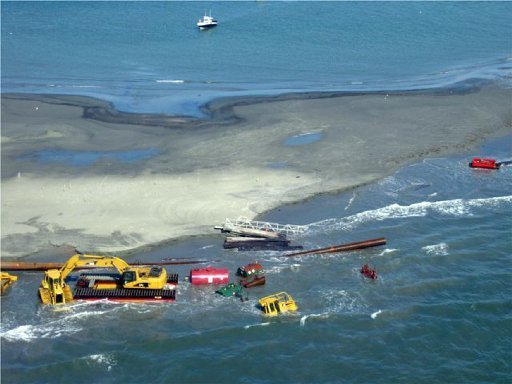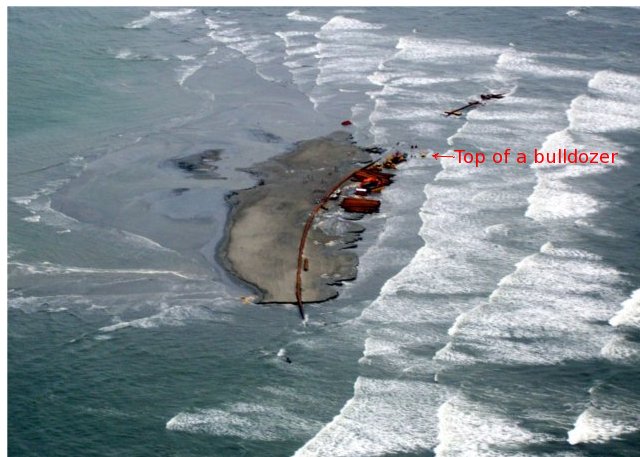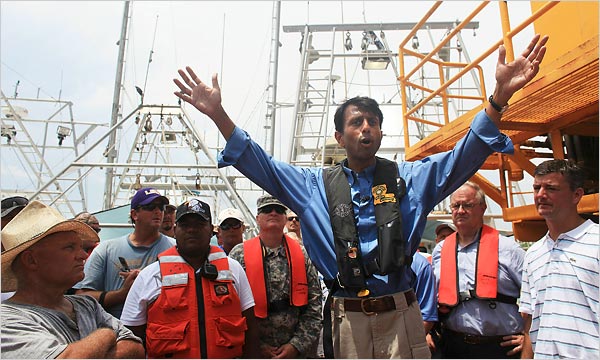A few years ago, the good people who conduct the U.S. Geological survey realized that the most powerful and effective way to describe the destruction of the Louisiana coastline was to put it in a language that we all understand: Football. Right now, in Louisiana, we lose an entire football field every hour due to coastal erosion.
The destruction of the Louisiana coast and marshlands is, without question, the single largest existential threat to the state’s economy, culture, habitat, and environment. And it’s made all the more insidious because this destruction is gradual (to mix environmental metaphors, you could also say, it’s glacier). We don’t experience it in real-time; it cannot be documented as dramatically as melting icebergs plunging into to the frigid Arctic Ocean. In Louisiana, coastal erosion is tracked through the never-ending, seemingly peaceful, and somnambulant sounds of waves lapping up and then receding on small, uninhabitable marshlands, most of which are at least a hundred miles from any sign of human civilization.
Quoting from The Times-Picayune (back in 2011):
“If that loss were to occur at a constant rate, it would be equal to losing more land than the island of Manhattan every year,” Couvillion said.
Preliminary measurements for the years 2009 and 2010 indicate what could be the beginning of a positive trend: a loss of only 3 square miles of wetlands.
To be fair, we’ve been able to curb some of this destruction through targeted infrastructure investments, rebuilding and repairing far-flung marshes, and no doubt, the coast is continually imperiled by large-scale hurricanes and storms. Quoting again:
That rapid loss rate was likely from several causes, Turnipseed and Couvillion said. Subsidence in wetlands in the Barataria Basin quickly followed the rapid drawdown of oil and gas beneath them. But part of the loss was likely the result of what Couvillion refers to as “sediment deprivation.”
“We built levees and sediment is no longer allowed to get out there and sustain these marshes and help them keep up with sea level rise and the subsidence that may have been in part related to oil and gas extraction,” he said. The loss of sediment also is liked to the rapid development of dams for hydropower and other purposes on the Missouri and upper Mississippi rivers, which captured sand and dirt that would otherwise have traveled to Louisiana.
But the inconvenient truth, to borrow a term from Vice President Al Gore, is that coastal erosion in Louisiana is largely the result of man-made interventions: Levee systems that rerouted the depositing of critical sediment, the building blocks of our marshes, into other areas; the industrialization of our gulf waterways and channels in order to accommodate the oil and gas extraction industry; the construction of large electric dams further upstream.
Yesterday, we learned that during the last two years, Governor Jindal has raided nearly $45 million from the Rigs-to-Reefs fund, which, as its name implies, requires rig operators to contribute a certain portion of their income to create and develop infrastructure projects along the Louisiana coast that could offset some of this destruction. But instead of spending that $45 million on needed coastal restoration projects, Jindal pilfered from the fund in order to offset losses in the State’s General Fund. Thankfully, the Board of the Artificial Reef Fund is now speaking out and making it abundantly clear that, for them, Jindal’s use of their monies is unconstitutional. Quoting (bold mine):
One such program is the Artificial Reef Development Fund, also known as the Rigs to Reefs Program. Since 2010, Jindal has taken $45 million fromthe fund to cover budget overruns, and after sitting on their hands for a few years, the commission that oversees the program is considering fighting against the governor who appointed them in order to recover the money.
The Wildlife and Fisheries Commission held a closed-door session today in Baton Rouge to consider filing suit. The board, which is entirely comprised of Jindal appointees, did not take any action on the matter Thursday, but its leaders say they are convinced that the governor’s use of the money violates the state Constitution.
“It’s in the Conservation Fund and the Conservation Fund is protected by the Constitution,” said Ronny Graham, the board’s newly installed chairman. “The money that comes into the Rigs to Reefs Program or the donation to the Conservation Fund into that, it specifically says it should be used for that program.”
The fund was set up to collect donations from oil companies when their offshore rigs come to the end of their useful lives.
The companies agreed to give the Department of Wildlife and Fisheries the old rigs and half the money they would have spent to disassemble and remove them so the state can pay to move the structures and turn them into fisheries habitats.
Every act of donation explicitly says the money is “to be placed in the Artificial Reef Fund for the benefit of the Louisiana Artificial Reef Development Program.”
Jindal offered this pathetic response (again, bold mine):
“We’re confident that the law has allowed for unused, excess dollars to be used to protect higher education and health care,” said Kristy Nichols, Jindal’s commissioner of administration. “Any time we use statutory funds in this way, we ensure that the core mission of the fund is protected.”
And maybe, to some, that sounds legitimate: “Unused, excess dollars” paying for education and heath care,” says Team Jindal. But unfortunately, for Jindal, that is not even remotely true. From WWLTV (bold mine):
But, as conservative budget hawk Rep. Cameron Henry, R-Metairie, points out, the core mission of the fund is not education or health care in any way. In fact, the oil companies are promised that the donations will go only to building the reefs.
“The oil companies are paying into this for a specific purpose and our constituents believe we’re taking this money and using it the best to save the coast,” Henry said. “I mean, that’s what Louisiana needs to do, and we’re not going that route.”
And Henry also notes that the administration did not use the money exclusively for education and health care. In fact, news reports in 2010 said that more than $12 million of the $18 million taken from the fund that year financed legislative pork.
“They’ve used it for slush funds, for projects for members (of the Legislature),” Henry said.
Henry and another conservative legislator, Rep. Kirk Talbot, R-River Ridge, have already sued the state attorney general and treasurer for what they say are Constitutional violations in the use of hundreds of millions of dollars from one-time revenue funds, including the Artificial Reef Fund.
“The Handgun Permit Fund, the Litter Abatement Fund — all these permits we have that people pay into when you get your driver’s license or your conceal and carry permit, used for a specific purpose — and the administration goes in at the end of the year and sweeps those funds and uses it for their discretion,” Henry said.
According to Representative Henry and Representative Talbot, Governor Jindal is not reallocating surplus monies from the Artificial Reef Fund in order to pay for education and health care; he’s unconstitutionally pilfering from the Rigs to Reef program to provide slush funds for unrelated projects to members of the legislature.
Then again, why would Jindal care about reef restoration and construction when he, alone, possesses the most brilliant coastal restoration plan in Louisiana history: Forcing BP, in the immediate aftermath of the Deep Water Horizon fiasco to fork over $220M to construct sand berms, berms that would not only trap the oil washing on our shores, but berms that could also serve as a steady, long-term investment in rebuilding precious infrastructure in our most environmentally vulnerable places.
Except that: Jindal’s sand berm project was a failure of epic failure, a failure so open and obvious that it seemed like a foregone conclusion before the first shovel hit the ground. Quoting USA Today:
The presidential commission investigating the BP Gulf of Mexico spill has concluded that Louisiana Gov. Bobby Jindal wasted $220 million building controversial sand berms that captured a “minuscule amount” of oil and proved to be “underwhelmingly effective” and “overwhelmingly expensive.”
The 36 miles of berms, constructed over the objections of many scientists and federal agencies, trapped only about 1,000 barrels of oil out of the nearly 5 million barrels that spilled between April and July, the National Oil Spill Commission said in a draft report released today.
Jindal later responded:
This report is partisan revisionist history at taxpayer expense.
The Commission would do a true service to Americans by recommending federal bureaucracies that can be eliminated or expedited in times of major disasters – like Hurricane Katrina and the BP oil spill, instead of attacking the politics of Louisiana and Huey Long.
The report’s assertion that the berms did not pass the commission’s “cost benefit analysis” is insulting to the thousands of people whose way of life depends on the health of our working coast. What exactly is the cost of thousands of jobs and generations of fishermen and oyster harvesters who have made their living off of our coast for over 100 years? I would like the Administration to provide us with an estimate of the ‘cost’ that they did not deem worthy of every action possible to protect coastal families.
We are thrilled that this has become the state’s largest barrier island restoration project in history.
Here is Jindal’s photographic evidence that his initiative saved thousands of jobs and generations of fishermen and oyster harvesters:





The oil spill berm project was a major success! The sand is still there and is now the base upon which the state is rebuilding substantial, sustainable barrier islands–our true first line of defense against storm surge and the damage it causes to our marsh and estuarial environment. John Snell of Fox8 TV in New Orleans just did a story on the success being achieved:
http://www.fox8live.com/story/21079199/pipe-delivers-a-beach-by-long-distance
Different projects.